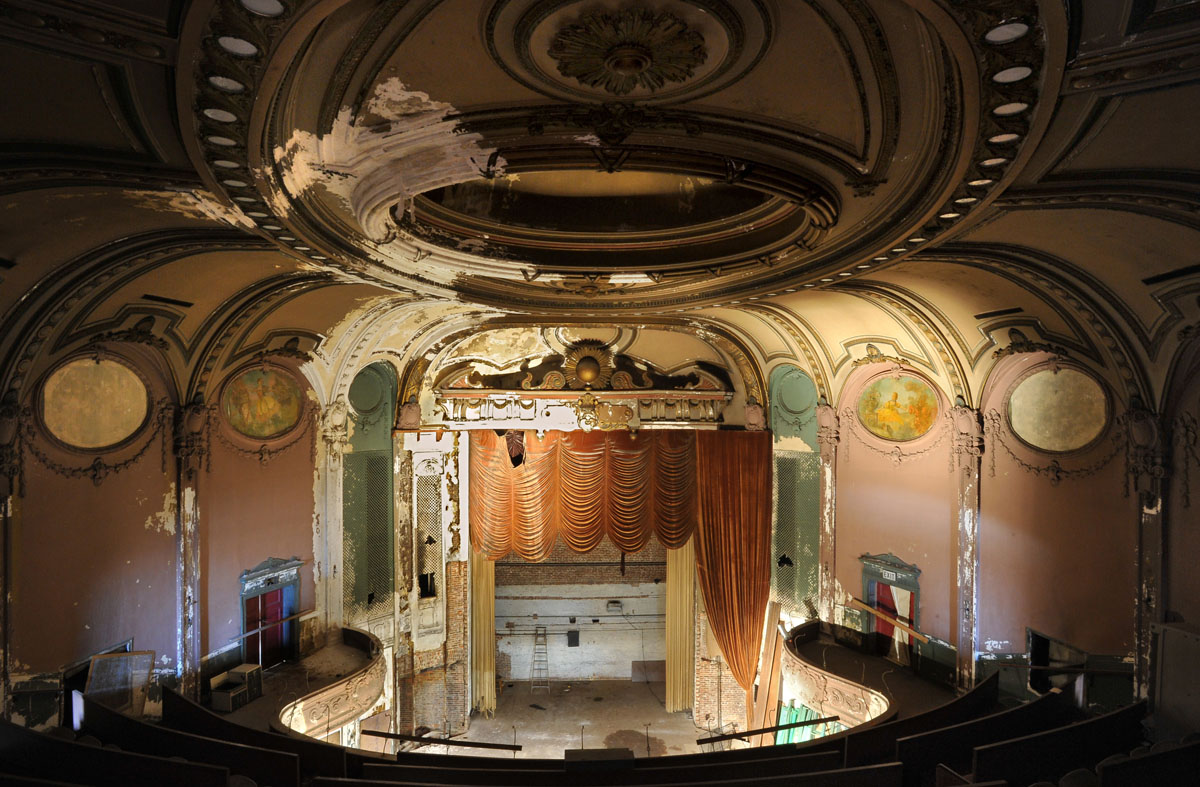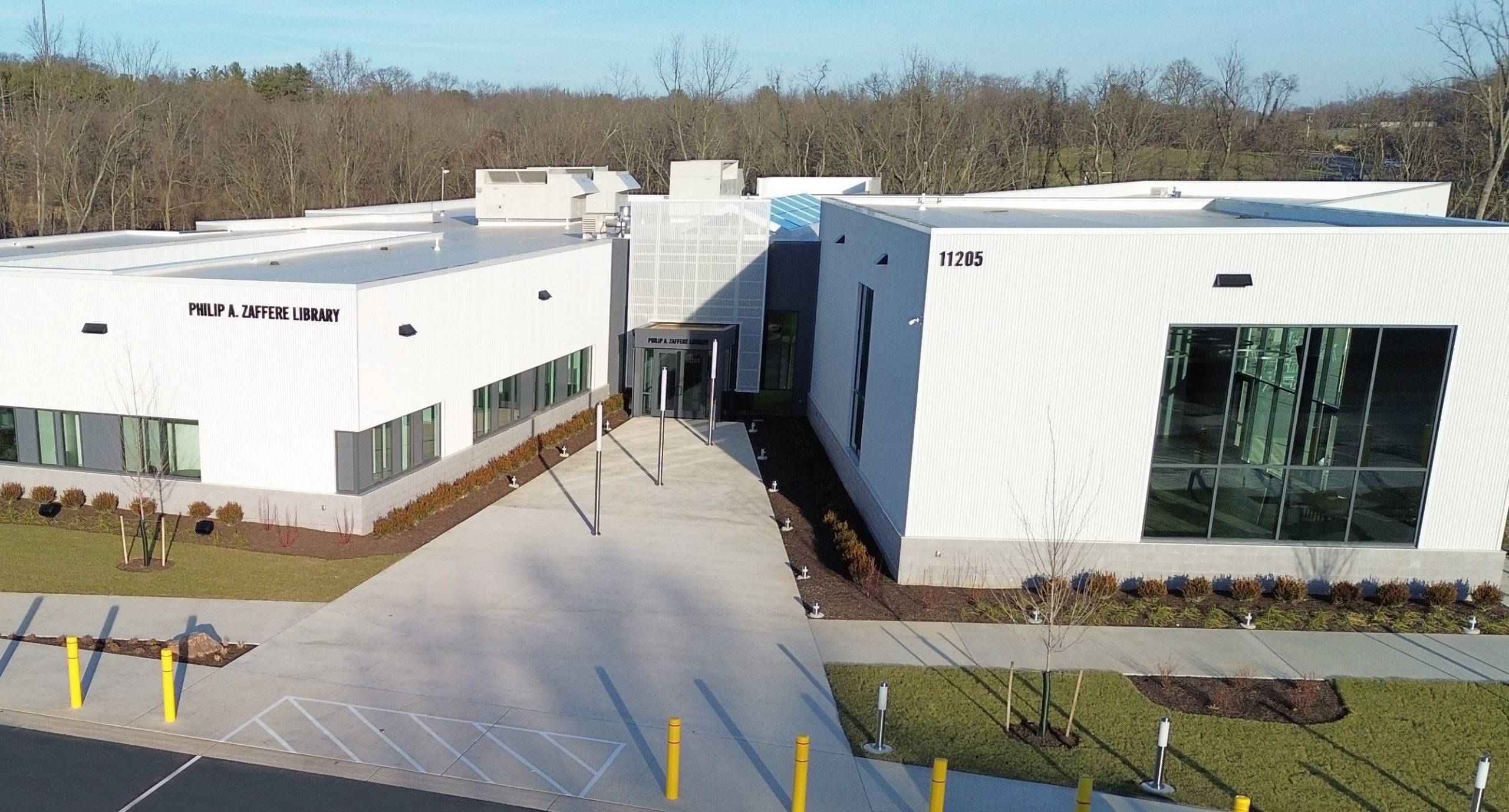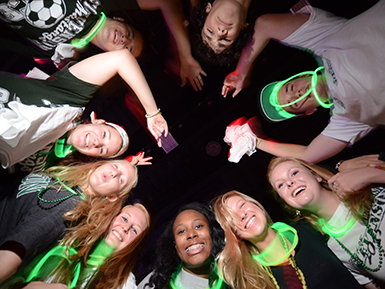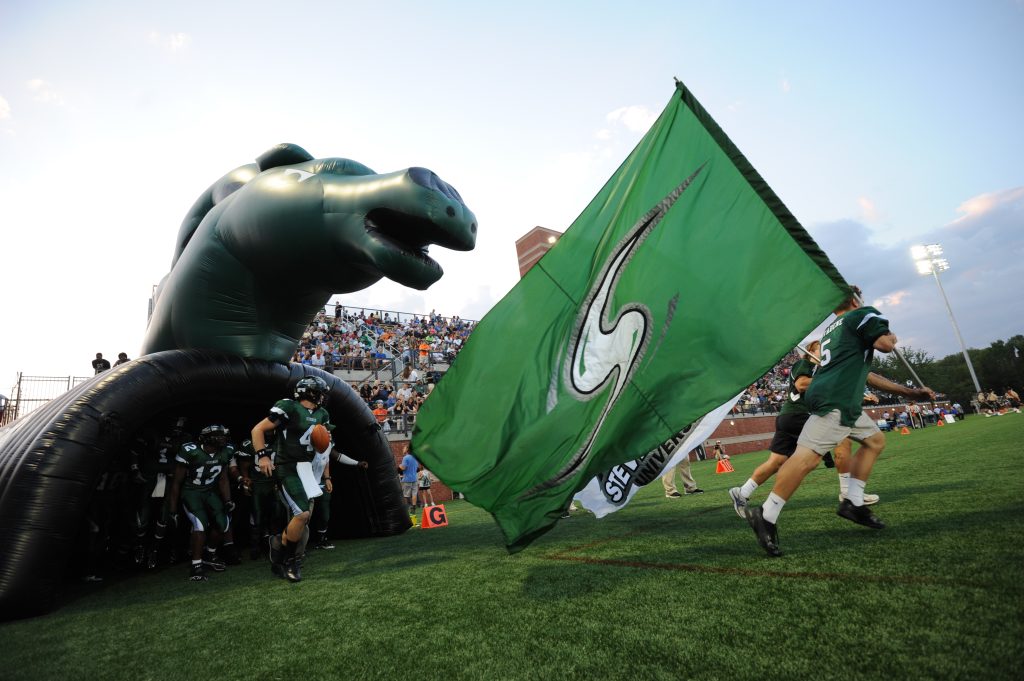
When Professor Lauren Schiszik brought her class to Baltimore’s newly renovated Parkway Theater, it was meant to be a simple excursion highlighting the sympathetic renovation of the structure. For those of us who went along, it rapidly became a surreal experience of proportions as magnificent as the theater itself.
Caption: In foreground Professor Lauren Schiszik and PHIST major Zane Wetzel. in rear (L to R) Nikol Akalestos, PHIST majors Anthony Plaag, Caroline Smith, Stephanie Czeslowski, Austin Knox, and PHIST Phriend Doug Rose.
On a mid-September evening, Lauren and students in her historic preservation course, Brothels, Bridges, and Barns, went to the Parkway in order to hear Amy Davis talk about her recently published book, Flickering Treasures: Rediscovering Baltimore’s Forgotten Movie Theaters. For many of us, Amy’s talk was also a golden opportunity to see the newly renovated Parkway. While Amy focused on the plurality of historic Baltimore theaters, the focus of the class trip was singular. What worked brilliantly was that our appreciation for the singular Parkway was placed within an all important historical context provided by the “plurality” described as part of Amy’s talk.
Caption: Architect’s concept rendering of the restored Parkway ( Photo courtesy of HimmelrichPR on Flckr )
An incredibly beautiful entertainment venue when opened in 1915, the Parkway had served the public as both a movie theater and a vaudeville stage for over 63 years. Closing in 1978, the Parkway had been neglected for nearly another 35 years before local community powerhouse organizations like the Maryland Film Festival, Johns Hopkins University, and the Maryland Institute College of Art agreed to back its renovation. Major funding for the project came from the Stavros Niarchos Foundation.
Rather than trying to return the Parkway to its former glory, the renovation instead sought to stabilize the structure and rescue it for the future. The resulting product is a structure that exists in a place neither here nor there. To be in that place is to have one foot in the present, one foot in the past, and a mind filled with fleeting images of what it must have been like in its heyday. When we entered the Parkway that night in September we entered a dream.
Caption: Like pearls, an oval of lights surrounds the Parkway’s dome.
As dusk fell across the city, we walked through the Parkway’s main doors and followed the crowd. Passing throngs of individuals lined up to purchase Amy’s book, we entered a space that had been added onto the original Parkway as part of its renovation. Feeling new and shiny, it had been designed as a multipurpose area which that evening served as a venue for both the reception and book signing. An energy pervaded the reception area within which icons of the Baltimore arts scene mixed with grad students, film aficionados, and historic preservationists. A bohemian atmosphere lent the gathering a mood of informality and lack of convention that I–a NYC kid–find so distinctive to Baltimore. Waiting in line to have his book signed–towering above everyone else and unmistakable in his visage–was film director, screenwriter, author, and community supporter, John Waters. Through his demeanor he made it clear that evening was not about him. Instead, it was about Amy, her book, and the wonderful theater palaces of old. You’ve got love it.
Caption: John Waters graciously agrees to have his photo taken with PHIST major Caroline Smith
As we left the reception to head to our seats in the balcony, the former beauty of the theater shown through on muted display. I use the phrase “muted display” because the rescue of the theater was never meant to return it to its original bright and colorful appearance. Instead, fresco-like paintings adorn walls and ceiling cameos, and portions of walls show original layers of paint, plaster, and brick. Low lighting adds a deep hue to maroons, blues, and gilt colors throughout the theater, and lights shine like pearls from far overhead. Portions of the theater, like the original projection booth, stand seemingly untouched since last used in 1978.
Caption: Original flooring, woodwork, tile, and marble have been rescued and remind us of the investment that had been made in the original theater. Caption: A great example of sympathetic rescue as opposed to a full restoration of the theater.
As we listened to Amy’s talk and admired images of dozens of former theaters displayed on the Parkway’s huge screen, we were returned to a time none of us had experienced, a time when movie palaces were at their zenith. Her narration allowed us to feel the joy of being rescued from a painful blue collar existence during the 1920s by a visit to one of Baltimore’s movie theaters. We could feel how the torturous heat and humidity of a summer’s day could be broken by buying a ticket to an air conditioned movie palace during the Depression. As we sat in the dim light of the balcony it seemed we were surrounded by voices from the past–Charlie Chaplin, Mary Pickford, Buster Keaton, Greta Garbo, WC Fields, Mae West, the Dead End Kids, Clark Gable, Bette Davis, and Humphrey Bogart. It was as if their appearances on the theater’s screen had left them inhabiting the very space in which we sat. The magic of the Parkway to transform the lives of its movie goers had not ended in 1978; our experience that night left us transformed as well. Amy Davis, the Parkway, and a vivid imagination had made their mark.
Caption: The audience as captured that evening. (Photo courtesy of Amy Davis at Flickering Treasures)
As Cara Ober of BmoreArt Magazine described: “Its balcony boasts voluptuous curves, ornately laced with bits of remaining molding featuring dramatic masks and laurels of flowers. Four stories up, the projection booth is still equipped with a giant carbon arc projector and a catwalk above a grand, domed ceiling.”
Caption: Our balcony seats before the lights dropped and the presentation began.
As the evening ended and we left the theater, we gathered outside to say goodbye to each other and to head off to our cars. We left the world of the Parkway and rejoined the world of today. On the way home we spoke to each other about our experience that evening. We shared our thoughts, but not our feelings. We got back to Stevenson and went about our lives.
Caption: Outside the Parkway Theater at night.
The next day I was telling someone about my experiences that evening and I was struck by a feeling I’ve often felt as a public historian–not being exactly sure of what had been real and what I had dreamed. To this day I cannot shake the feeling that what I experienced that night was a different experience than just going to a talk. How much was a dream and how much reality? Does the answer to that question even matter? Is dreaming bad in public history, or is it necessary to “dream” in order to begin to understand the past? I’m not sure, but I can’t wait to travel through time again.
For those interested in meeting the author of Flickering Treasures: Rediscovering Baltimore’s Forgotten Movie Theaters, Amy Davis will be at the Ivy Bookshop for a reading on Tuesday, November 28th. She will also be at the Carroll Arts Center in Westminster on Wednesday, November 29th, where she will be presenting a slide show derived from her publication. You can always learn more about her book and her activities regarding that publication at www.flickeringtreasures.com.
Masthead photo of Parkway Theater under renovation courtesy of Parkway Theater.





